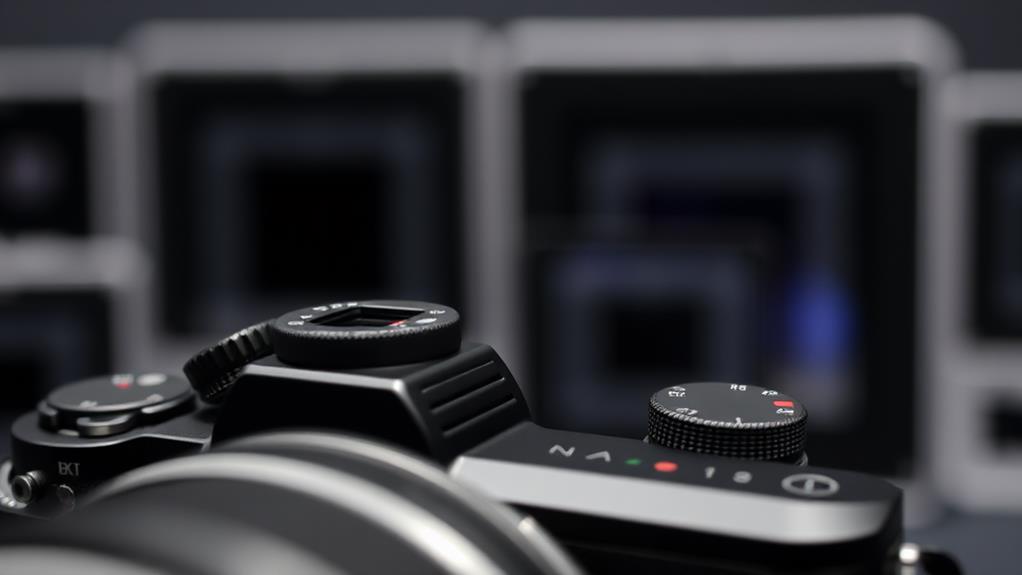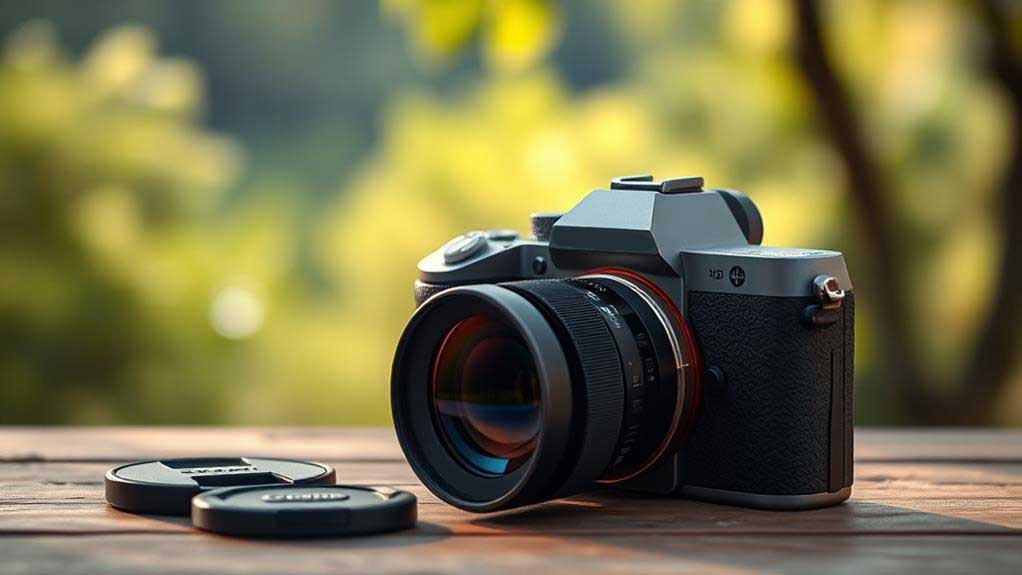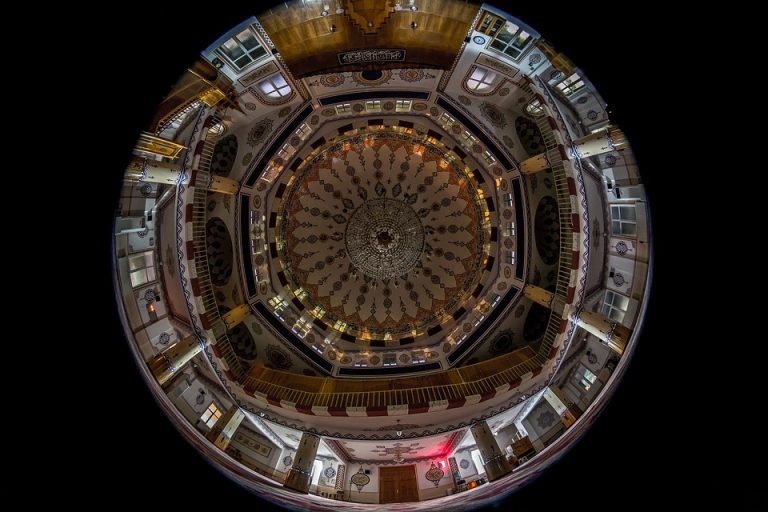Links below are affiliate links. We earn a commission on purchases at no extra cost to you. Although our opinions are based on curated research, we have not used these products. Article generated with AI.
Mirrorless cameras offer advanced features in compact bodies, rivaling traditional DSLRs. Top models include the Canon EOS R100, R6 Mark II, and R7, each with unique strengths in sensor technology and autofocus capabilities. Sony’s Alpha series, including the a6400, ZV-E10, and A6100, provides excellent image quality and vlogging features. The Panasonic LUMIX G95D offers versatility with its 20.3-megapixel sensor. When choosing a mirrorless camera, consider factors like sensor size, resolution, autofocus performance, and video capabilities. These cameras cater to enthusiast photographers and videographers, balancing portability with high-end features. Further exploration will reveal how these models can elevate your photography and videography skills.
Highlights
- Top mirrorless cameras include models from Canon EOS R and Sony Alpha series, offering high-quality sensors and advanced autofocus systems.
- Full-frame sensors, like in the Sony a7 III, provide superior low-light performance and dynamic range for professional-grade images.
- Advanced autofocus technologies, such as Eye Detection AF and subject tracking, enhance image sharpness across various shooting scenarios.
- 4K video capabilities at 60fps are common in high-end mirrorless cameras, catering to both photographers and videographers.
- In-body image stabilization (IBIS) is a crucial feature in many top mirrorless cameras, reducing camera shake for clearer images.
Canon EOS R100 Mirrorless Camera with Dual Lens Kit
Canon EOS R100 Mirrorless Camera with Dual Lens Kit
Introducing the compact and lightweight EOS R series camera! With a 24.1MP sensor, DIGIC 8 processor, and Dual Pixel CMOS AF, it’s perfect for great mobility and stunning image quality—ideal for capturing life’s moments with up to 6.5 shots per second!
For photographers seeking a compact yet powerful entry into the mirrorless world, the Canon EOS R100 with its dual lens kit stands out. This camera boasts a 24.1-megapixel APS-C sensor and DIGIC 8 processor, delivering high-quality images, especially in low-light conditions. You’ll appreciate its 4K video capability at 24 fps and Full HD at 60 fps. The Dual Pixel CMOS AF system, with 143 zones and Eye Detection AF, guarantees fast and accurate focusing.
The R100’s lightweight design, weighing just 12 ounces, makes it highly portable. It’s compatible with WiFi and Bluetooth for easy photo transfer. While it offers intuitive controls for beginners, some users note less accessible controls compared to higher-end models. The included RF-S18-45mm and RF-S55-210mm lenses provide versatility for various shooting scenarios. However, you might consider investing in full-frame RF lenses for future upgrades.
Best For: Entry-level photographers and smartphone users looking to upgrade to a compact, versatile mirrorless camera system with room for growth.
Pros:
- High-quality 24.1-megapixel APS-C sensor and DIGIC 8 processor for excellent image quality
- Lightweight and portable design, ideal for travel and everyday use
- Dual lens kit provides versatility for various shooting scenarios
Cons:
- Limited battery life reported by some users
- Autofocus issues as noted, particularly with manual settings
- Less accessible controls compared to higher-end models
Panasonic LUMIX G95D 20.3 Megapixel Mirrorless Camera with 12-60mm Lens
Panasonic LUMIX G95D 20.3 Megapixel Mirrorless Camera with 12-60mm Lens
Unleash your creativity with the LUMIX G95M, featuring a powerful 20.3 MP sensor for stunning photos and videos. This lightweight, weather-sealed mirrorless camera captures exceptional 4K footage and offers advanced editing tools, making every adventure unforgettable.
Photographers seeking versatility and advanced features will find the Panasonic LUMIX G95D an excellent choice. This 20.3 megapixel mirrorless camera boasts a 12-60mm lens, offering flexibility for various shooting scenarios. Its 5-Axis Dual I.S. 2 stabilization guarantees sharp images, even in challenging conditions. You’ll appreciate the 4K video capabilities, recording at 24p and 30p, with pre-installed V-Log L for enhanced editing options.
The G95D’s weather-sealed body allows you to shoot confidently in adverse conditions, while the 3″ OLED touchscreen provides easy control and framing. You’ll find features like Live View Composite and Post-Focus useful for creative shots. The camera’s lightweight design makes it ideal for travel, and its user-friendly interface suits both beginners and experienced photographers. While low light performance may be limited due to its Micro Four Thirds sensor, the G95D offers excellent image quality and stabilization for most shooting situations.
Best For: Enthusiast photographers and videographers seeking a versatile, weather-sealed mirrorless camera with advanced features for both stills and 4K video.
Pros:
- Excellent 5-Axis Dual I.S. 2 stabilization for sharp images in various conditions
- Weather-sealed body and lightweight design ideal for outdoor and travel photography
- Advanced features like 4K video, V-Log L, and Post-Focus for creative flexibility
Cons:
- Limited low light performance due to Micro Four Thirds sensor size
- Burst mode is restricted to 6 fps, which may not suffice for fast-action photography
- Some users report concerns about video capabilities and noise in shadow areas
Sony Alpha a6400 Mirrorless Camera with 16-50mm Lens (ILCE-6400L/B)
Sony Alpha a6400 Mirrorless Camera with 16-50mm Lens (ILCE-6400L/B)
High-performance compact camera with 20.1MP 1″ sensor, 24-70mm F1.8-2.8 ZEISS lens, and 425-point AF system. Features 11fps shooting, 4K video, time-lapse/slow-mo modes, and tiltable LCD. Includes essential accessories for versatile photography and videography.
Capturing stunning images and 4K video with ease, the Sony Alpha a6400 Mirrorless Camera with 16-50mm Lens is a versatile choice for both beginners and experienced photographers. This compact APS-C mirrorless camera boasts a 20.1MP stacked back-illuminated Exmor RS CMOS sensor, delivering crisp and colorful images. Its advanced autofocus system, featuring 425 phase detection and 425 contrast detection points, guarantees sharp focus in various shooting scenarios. The a6400 excels in continuous shooting, capturing up to 11 frames per second at 24.2 MP raw. While the camera performs well in low light conditions up to ISO 1200, higher settings may result in noticeable grain. The tiltable LCD screen enhances usability, though it can obstruct the hot shoe when flipped up. With decent battery life and a user-friendly menu system, the a6400 offers good value for its price range of approximately $900.
Best For: Photographers and videographers seeking a versatile, compact mirrorless camera for travel, vlogging, and everyday shooting.
Pros:
- Advanced autofocus system with 425 phase detection and 425 contrast detection points
- Impressive 4K video capabilities and high-speed continuous shooting up to 11 fps
- Compact, lightweight design with a user-friendly interface suitable for beginners and experienced users
Cons:
- Image quality degrades at ISO settings above 1200
- The flip-up screen can obstruct the hot shoe when in use
- Internal microphones are mediocre, requiring external mics for better audio quality
Sony Alpha ZV-E10 Mirrorless Vlog Camera Kit
Sony Alpha ZV-E10 Mirrorless Vlog Camera Kit
Powerful 24.2MP APS-C sensor with BIONZ X processor. 4K video from 6K oversampling. Product Showcase Setting for smooth focus transitions. Background Defocus button for instant effect toggle. Simple live streaming via USB. Advanced features in a compact, user-friendly camera for high-quality content creation.
Vloggers and content creators will find the Sony Alpha ZV-E10 Mirrorless Vlog Camera Kit a game-changer for their video production needs. This camera boasts a large 24.2MP APS-C sensor and a fast BIONZ X processor, delivering excellent image quality and 4K video oversampled from 6K. You’ll appreciate the Product Showcase Setting, which smoothly shifts focus from faces to objects, and the Background Defocus button for easy depth-of-field control. The flip-out vari-angle LCD and advanced audio options cater to vlogging requirements, while easy live streaming via USB eliminates the need for extra hardware. Despite its lightweight body and simple layout, the ZV-E10 offers professional features like picture profiles and S&Q mode for time-lapse and slow-motion video. However, be prepared for quick battery drain and limited touchscreen functionality.
Best For: Aspiring vloggers, content creators, and beginner videographers looking for a versatile, feature-rich camera with excellent image quality and user-friendly vlogging features.
Pros:
- Large 24.2MP APS-C sensor and 4K video capabilities deliver high-quality images and footage
- Vlogging-specific features like Product Showcase Setting and Background Defocus button
- Lightweight, compact design with flip-out vari-angle LCD for easy self-recording
Cons:
- Short battery life requires extra batteries or a dummy battery for extended use
- Limited touchscreen functionality compared to some competitors
- A steep learning curve for advanced settings may challenge some beginners
Canon EOS R6 Mark II Mirrorless Camera
Canon EOS R6 Mark II Mirrorless Camera
High-performance mirrorless camera with 24.2MP full-frame CMOS sensor, DIGIC X processor, and 40 fps shooting. Features advanced subject detection, 6K video, wireless connectivity, and high-speed USB-C. It features a vari-angle touchscreen and precise OLED viewfinder for versatile shooting.
For professionals and enthusiasts seeking a versatile powerhouse, the Canon EOS R6 Mark II stands out with its impressive 24.2-megapixel full-frame sensor and DIGIC X processor. This camera offers exceptional performance, with continuous shooting up to 40 fps and advanced autofocus capabilities. You’ll appreciate its ability to detect and track various subjects, including people, animals, and vehicles, making it ideal for wildlife and sports photography.
The R6 Mark II excels in low-light conditions, producing sharp, detailed images with minimal noise. Its video capabilities are equally impressive, allowing you to capture 6K oversampled 4K footage at up to 60 fps. The camera’s ergonomic design guarantees comfort during extended use, while built-in Wi-Fi and Bluetooth facilitate easy sharing. With its intuitive menu system and responsive touchscreen, you’ll find the R6 Mark II user-friendly and efficient for both stills and video work.
Best For: Professional photographers and serious enthusiasts who require high-performance gear for diverse shooting scenarios, including wildlife, sports, and low-light environments.
Pros:
- Exceptional autofocus system with advanced subject detection and tracking
- High-speed continuous shooting up to 40 fps for capturing fast-moving subjects
- Impressive low-light performance and image quality with minimal noise at high ISO
Cons:
- Higher price point compared to entry-level full-frame cameras
- Limited battery life may require additional batteries for extended shooting sessions
- Learning curve for users transitioning from older DSLR models to mirrorless technology
Canon EOS R50 Mirrorless Camera with RF-S18-45mm Lens Kit
Canon EOS R50 Mirrorless Camera with RF-S18-45mm Lens Kit
Advanced mirrorless camera with 12-15 fps continuous shooting, Dual Pixel AF, and superior low-light performance. Features 4K/30p video, 120fps Full HD, and 6K oversampling. Vari-angle touchscreen and EVF for flexible shooting. Wi-Fi and Bluetooth for easy file transfer and remote control.
The Canon EOS R50 Mirrorless Camera with RF-S18-45mm Lens Kit stands out as an ideal choice for aspiring content creators and photography enthusiasts. This hybrid camera boasts a 24.2 Megapixel APS-C sensor and DIGIC X processor, delivering high-quality images and 4K video capabilities. You’ll appreciate its advanced autofocus system, which uses deep learning technology to detect and track subjects across the entire frame. The camera’s user-friendly design includes a vari-angle touchscreen and smartphone-like operability, making it accessible for beginners.
With features like 6K oversampled 4K video at 30 fps and high-speed continuous shooting up to 15 fps, the EOS R50 caters to both photographers and videographers. Its compact size and lightweight build make it comfortable for extended use, while built-in Wi-Fi and Bluetooth enable easy file transfer and wireless functions.
Best For: Aspiring content creators, vloggers, and photography enthusiasts looking for a versatile, user-friendly mirrorless camera with excellent image quality and 4K video capabilities.
Pros:
- High-quality 24.2 Megapixel APS-C sensor and advanced autofocus system
- Compact, lightweight design with vari-angle touchscreen for easy operation
- Versatile features including 4K video, high-speed continuous shooting, and wireless connectivity
Cons:
- Limited battery life may require carrying extra batteries for extended use
- Potential overheating issues in high-temperature environments during prolonged video recording
- Entry-level positioning may lack some advanced features found in higher-end models
Sony Alpha A6100 Mirrorless Camera with Zoom Lenses (ILCE6100Y/B)
Sony Alpha A6100 Mirrorless Camera with Zoom Lenses (ILCE6100Y/B)
High-performance APS-C mirrorless camera with 24.2MP sensor, 425-point AF system, and 11fps shooting. Features real-time AF tracking for humans/animals, 4K video, and 3″ touchscreen. Includes electronic viewfinder, 180° tiltable LCD, and ISO up to 51,200. Comes with a battery, charger, and accessories.
Photography enthusiasts seeking a versatile and powerful mirrorless camera will find the Sony Alpha A6100 an excellent choice. This camera boasts a 24.2MP APS-C Exmor sensor, ISO up to 51,200, and impressive autofocus capabilities with 425 phase and contrast detection points. You’ll appreciate its lightning-fast 0.02-second autofocus speed and continuous shooting at 11fps with AF/AE tracking. The A6100 comes with two zoom lenses: 16-50mm and 55-210mm, suitable for various photography and videography needs.
The camera’s BIONZ X image processor and front-end LSI enhance image quality and overall performance. You can capture 4K videos and take sharp photos with ease. While users praise its versatility and lightweight design, some have noted the lack of weather sealing and a low-resolution viewfinder. Despite these minor drawbacks, the Sony Alpha A6100 offers excellent value for money and is well-suited for both novice photographers and wildlife enthusiasts.
Best For: Enthusiast photographers and videographers seeking a versatile, high-performance mirrorless camera with professional-quality zoom lenses at an affordable price point.
Pros:
- Impressive autofocus capabilities with 425 phase/contrast-detection points and real-time Eye AF
- Versatile kit with two zoom lenses (16-50mm and 55-210mm) for various shooting scenarios
- High-quality 4K video recording and 24.2MP APS-C Exmor sensor for excellent image quality
Cons:
- Lack of weather sealing limits use in challenging environmental conditions
- A low-resolution electronic viewfinder may not satisfy more demanding users
- Some users may find the menu system complex and overwhelming at first
Sony a7 III Full-frame Mirrorless Camera with 28-70mm Lens
Sony a7 III Full-frame Mirrorless Camera with 28-70mm Lens
High-performance full-frame mirrorless camera with 24.2MP BSI sensor, 15-stop dynamic range, and ISO up to 204,800. Features 10fps shooting, 693 AF points, and 93% image coverage. Includes SEL2870 lens, accessories, and 35mm Exmor R CMOS sensor for exceptional image quality.
Boasting a 24.2MP BSI full-frame image sensor and impressive low-light capabilities, the Sony a7 III Full-frame Mirrorless Camera with 28-70mm Lens is a powerhouse for professional photographers and serious enthusiasts. This camera offers a 15-stop dynamic range, ISO sensitivity up to 204,800, and 4K HDR movie recording. You’ll find 693 phase-detection and 425 contrast AF points, covering 93% of the image area. The a7 III excels in continuous shooting, reaching up to 10fps with AE/AF tracking. Its dual card slots and customizable controls enhance functionality, while the bright monitor with focus peaking aids in composition. Users praise its performance in challenging conditions and its compatibility with various lenses, including Canon optics via an adapter. However, some note limitations in face tracking during external recording and a complex menu system.
Best For: Professional photographers and serious enthusiasts seeking a versatile, high-performance full-frame mirrorless camera for both photography and videography.
Pros:
- Exceptional image quality with 24.2MP BSI full-frame sensor and excellent low-light performance
- Advanced autofocus system with 693 phase-detection points and impressive eye AF and face tracking
- Versatile 4K HDR video capabilities and 10fps continuous shooting with AE/AF tracking
Cons:
- Complex menu system that may require a learning curve for new users
- Only one UHS-II card slot, which may limit backup options for professionals
- Some users report issues with EVF color calibration and face tracking during external recording
Sony Alpha A6100 Mirrorless Camera with 16-50mm Zoom Lens
Sony Alpha A6100 Mirrorless Camera with 16-50mm Zoom Lens
High-speed 24.2MP APS-C camera with 0.02s AF, 425-point phase/contrast detection, and 11fps continuous shooting. Features real-time AF tracking for humans/animals, 4K movie recording, 180° tiltable touchscreen, and ISO up to 51,200. Includes electronic viewfinder and ±5.0 EV exposure compensation.
For aspiring photographers ready to leap from smartphone snaps to serious imagery, Sony’s Alpha A6100 Mirrorless Camera with 16-50mm Zoom Lens offers a compelling entry point. This camera boasts impressive specifications, including a 24.2MP APS-C Exmor sensor, lightning-fast autofocus, and 4K video capabilities. You’ll appreciate its user-friendly features, such as the 180-degree tiltable touchscreen and real-time Eye AF for both humans and animals. While the A6100 excels in image quality and low-light performance, it’s not without limitations. Some users find the electronic viewfinder subpar and the menu system convoluted. Additionally, concerns about Sony’s commitment to APS-C lenses and occasional overheating during 4K video recording are worth noting. Despite these drawbacks, the A6100 remains a solid choice for beginners evolving from smartphone photography, offering a balance of performance and affordability in the competitive mirrorless camera market.
Best For: Aspiring photographers transitioning from smartphone photography to more advanced imaging, seeking a feature-rich mirrorless camera with excellent autofocus and image quality at an entry-level price point.
Pros:
- Fast and accurate autofocus system with real-time Eye AF for humans and animals
- High-quality 24.2MP APS-C sensor with excellent low-light performance
- Versatile 180-degree tiltable touchscreen, ideal for vlogging and self-portraits
Cons:
- Subpar electronic viewfinder compared to higher-end models
- A convoluted menu system that can be challenging to navigate
- Limited lens options in Sony’s APS-C lineup compared to some competitors
Canon EOS R7 Mirrorless Camera (Body Only)
Canon EOS R7 Mirrorless Camera (Body Only)
Powerful 32.5MP APS-C camera with advanced autofocus, high-speed shooting up to 30 fps, and 5-axis stabilization. Captures professional 4K video with extended recording time. Compact, lightweight design ideal for on-the-go photography and videography.
Serious photographers seeking a versatile, high-performance camera will find the Canon EOS R7 Mirrorless Camera an impressive option. This APS-C sensor camera boasts a 32.5-megapixel resolution, providing excellent image quality and telephoto reach. You’ll enjoy high-speed continuous shooting up to 30 fps with the electronic shutter, perfect for capturing fast-moving subjects. The camera’s Dual Pixel CMOS AF technology, with 651 AF zones covering the entire frame, guarantees accurate focus detection and tracking.
For videographers, the R7 offers 4K 60p recording capabilities with Movie Servo AF, allowing for smooth subject tracking. The 5-axis In-body Image Stabilization (IBIS) helps produce shake-free images and videos. Weighing just 1.1 lbs, it’s compact and lightweight, making it easy to carry on your photography adventures. The camera’s dual UHS-II card slots provide redundant storage options, while its compatibility with RF, RF-S, EF, and EF-S lenses (via adapters) enhances its versatility.
Best For: Enthusiast photographers and videographers seeking a high-performance, versatile APS-C mirrorless camera with excellent autofocus capabilities and fast burst shooting.
Pros:
- High-resolution 32.5MP APS-C sensor with impressive autofocus and subject tracking
- Versatile 4K 60p video recording with no time limit and in-body image stabilization
- Compact and lightweight design with dual UHS-II card slots for reliability
Cons:
- Higher price point compared to some other APS-C cameras
- Limited native RF-S lens selection, though adaptable with EF/EF-S lenses
- The smaller sensor size may not appeal to those seeking full-frame image quality
Factors to Consider When Choosing Mirrorless Cameras

When choosing a mirrorless camera, you’ll need to weigh several key factors that impact performance and versatility. These include the sensor size and resolution, which affect image quality and low-light capabilities, as well as the camera’s autofocus performance and image stabilization features. Additionally, you should evaluate the video recording capabilities and lens compatibility options to guarantee the camera meets your specific needs and creative goals.
Sensor Size and Resolution
As you explore the world of mirrorless cameras, two essential factors to take into account are sensor size and resolution. These elements notably impact image quality, low-light performance, and overall camera capabilities. Mirrorless cameras typically feature either APS-C or full-frame sensors, with APS-C sensors having a crop factor of 1.5x to 1.6x compared to full-frame. Full-frame sensors offer a wider field of view and improved dynamic range, but they often result in larger, heavier camera bodies and lenses.
Sensor size directly affects depth of field and low-light performance. Larger sensors generally provide better image quality and sensitivity, allowing you to capture clearer photos in challenging lighting conditions. Resolution, measured in megapixels, determines the level of detail in your images. Higher-resolution sensors enable you to crop or enlarge photos without sacrificing quality. However, it’s important to balance resolution with your specific needs, as extremely high megapixel counts can lead to larger file sizes and potentially slower processing speeds. When choosing a mirrorless camera, consider how sensor size and resolution align with your photography goals and shooting preferences.
Autofocus Performance
Today’s mirrorless cameras boast impressive autofocus systems that can make or break your shooting experience. When evaluating autofocus performance, you’ll want to take into account several key factors. The number of focus points is an essential metric, with high-end models offering hundreds of phase detection and contrast detection points. This abundance of focus points enables faster and more accurate focusing across the frame.
Advanced technologies like Dual Pixel AF and Real-Time Eye AF take autofocus capabilities even further. These systems excel at tracking subjects, including people and animals, ensuring sharp images in dynamic situations. You’ll also want to pay attention to continuous shooting speeds, which can reach up to 40 frames per second in some models. Effective autofocus systems maintain tracking during these high-speed bursts, allowing you to capture fast-moving action with precision.
Low-light autofocus performance is another vital aspect. Many mirrorless cameras can focus effectively down to -6 EV, enabling you to shoot in challenging lighting conditions. Some models even incorporate deep learning algorithms for subject detection and tracking, automatically recognizing and following specific subjects. These advanced features can greatly enhance your ability to capture sharp, well-focused images in various shooting scenarios.
Image Stabilization Capabilities
While autofocus performance helps you capture sharp images, image stabilization capabilities guarantee your shots remain blur-free, even in challenging conditions. When choosing a mirrorless camera, you’ll want to take into account the type and effectiveness of its stabilization system. Many cameras now feature in-body image stabilization (IBIS), which moves the sensor to counteract camera shake. This technology is particularly useful as it works with any lens you attach to the camera.
Some advanced IBIS systems offer 5-axis stabilization, compensating for vertical and horizontal movements, as well as pitch, yaw, and roll. This thorough approach is especially beneficial for handheld shooting and video recording. You’ll also find lens-based stabilization in some models, which adjusts lens elements to reduce shake. The effectiveness of stabilization systems is often rated in stops, with higher ratings indicating better performance. A good stabilization system allows you to use slower shutter speeds without introducing blur, improving low-light performance and enabling longer exposure photography. When comparing cameras, pay attention to their stabilization capabilities, as this feature can greatly impact image quality, particularly in challenging shooting conditions or when recording video.
Video Recording Features
Many photographers are now turning to mirrorless cameras for their video recording capabilities. When evaluating a mirrorless camera for video, you’ll want to look for models that offer 4K recording, which has become the standard for high-quality video production. This resolution provides detailed imagery during playback, enhancing your final product.
Frame rates are another vital factor to evaluate. Look for cameras that offer 60 fps (frames per second) for 4K and even higher frame rates for Full HD. These options will give you smoother footage and more versatility in post-production. In-body image stabilization (IBIS) is a valuable feature that can greatly reduce camera shake during handheld shooting, resulting in steadier video footage.
Audio quality is often overlooked but is essential for professional-grade videos. Choose cameras with external microphone and headphone jacks to improve sound recording and monitoring. For advanced users, features like V-Log support can be advantageous. V-Log allows for greater dynamic range and flexibility in color grading, making it ideal for professional video work. By evaluating these factors, you’ll be well-equipped to choose a mirrorless camera that meets your video recording needs.
Lens Compatibility Options
Lens compatibility stands as an essential factor when choosing a mirrorless camera. When selecting a system, you’ll need to take into account the range of lenses available, as this directly impacts the types of photography you can pursue. Many mirrorless cameras support both native and third-party lenses, giving you flexibility in your choices based on your budget and specific requirements. Some systems offer adapters, allowing you to use lenses from other formats, which can be particularly helpful if you’re moving from a DSLR.
The mount type, such as RF or E-mount, is a vital consideration, as it determines which lenses will fit your camera. You’ll want to research the available options for your chosen mount to guarantee you have access to the lenses you need. Additionally, it’s important to understand how sensor size affects lens performance. Lenses designed for APS-C or full-frame sensors will produce different fields of view and depth of field characteristics, influencing your final images. By carefully evaluating these factors, you can choose a mirrorless system that offers the lens compatibility options best suited to your photographic goals and style.
Ergonomics and Controls
Beyond lens compatibility, the ergonomics and controls of a mirrorless camera play a key role in your shooting experience. When choosing a camera, you’ll want to reflect on how comfortable it feels in your hands during extended use. Look for models with well-designed grips and thoughtfully placed buttons and dials, as these features can greatly impact your ability to adjust settings quickly, especially in fast-paced shooting situations.
The layout of controls is vital for efficient operation. Some cameras offer customizable buttons, allowing you to tailor the interface to your specific needs and shooting style. This level of personalization can greatly enhance your workflow. Additionally, reflect on the camera’s weight and size, particularly if you plan to travel or shoot outdoors frequently. A lightweight, compact design can make a noticeable difference in comfort during long photo sessions. Touchscreen functionality is another factor to evaluate, with some models offering limited touchscreen capabilities for menu navigation while excelling in other areas like focus tracking. By carefully examining these ergonomic aspects, you can select a mirrorless camera that not only meets your technical requirements but also feels comfortable and intuitive to use.
Frequently Asked Questions
How Do Mirrorless Cameras Compare to DSLRS in Terms of Battery Life?
You might find that mirrorless cameras don’t quite measure up to DSLRs regarding battery endurance. Generally, DSLRs offer longer battery life due to their optical viewfinders, which consume less power. Mirrorless cameras, relying on electronic viewfinders and LCD screens, tend to drain batteries faster. However, it’s worth noting that newer mirrorless models are improving in this area. You can always carry spare batteries or use battery grips to extend shooting time with mirrorless cameras.
Can I Use My Existing DSLR Lenses on a Mirrorless Camera?
You can often use your DSLR lenses on a mirrorless camera, but you’ll need an adapter. These adapters allow you to mount DSLR lenses onto mirrorless bodies, maintaining the optical quality of your existing glass. However, you might lose some functionality, like autofocus speed or certain camera features. It’s important to check compatibility between your specific lenses, adapter, and mirrorless camera model. Some manufacturers offer their own adapters, which typically provide better integration and performance than third-party options.
Are Mirrorless Cameras Suitable for Professional Sports and Wildlife Photography?
Did you know that 70% of professional sports photographers now use mirrorless cameras? You’ll find that mirrorless cameras are increasingly suitable for professional sports and wildlife photography. They offer fast autofocus systems, high burst rates, and excellent image quality. While some early models had limitations, modern mirrorless cameras have overcome these issues. They’re now capable of tracking fast-moving subjects, handling low-light conditions, and providing the durability needed for demanding environments. You’ll also appreciate their lighter weight compared to traditional DSLRs.
What’s the Difference Between Full-Frame and Crop Sensor Mirrorless Cameras?
When you’re choosing between full-frame and crop-sensor mirrorless cameras, you’ll notice key differences. Full-frame sensors, roughly the size of 35mm film, capture more light and provide better low-light performance. They also offer a wider field of view. Crop sensors, smaller in size, have a narrower field of view but can provide extended reach for telephoto shots. Full-frame cameras typically produce higher image quality but are more expensive, while crop sensors offer a more affordable option with compact bodies.
How Does In-Body Image Stabilization (Ibis) Work in Mirrorless Cameras?
You’d think cameras wouldn’t need to move to stay still, but that’s exactly how IBIS works. In-body image stabilization uses sensors to detect camera movement. When you’re shooting, the camera’s sensor shifts to counteract this motion, reducing blur. It’s like having steady hands, even if you don’t. IBIS can compensate for various types of movement, including pitch, yaw, and roll. This technology is especially useful in low-light conditions or when using longer lenses.














